A Parent's Guide To Nonfiction 1m2m6y
About Martha's True Stories 5j92o
Martha's True Stories is a great way to introduce your child not only to interactive books, but also what reading nonfiction offers: fun and intriguing information. The colorful, playful online format will engage and excite kids, and the texts will teach them new facts and new words. Learning new words is important because the more words children know and understand—especially the kinds of challenging words highlighted in these stories—the better they will do in reading and in school. 37255h
Martha's True Stories are divided into four "STEM" (Science, Technology, Engineering, and Math) categories. Within each category, you'll find two nonfiction stories about the topic, plus another kind of nonfiction "text" (instructions, recipe, a made-up website, and so on). You can also watch the four related Martha Speaks videos (one for each STEM topic). After you read the stories, you can review the words using the Word Bones interactive glossary. There is also a short but fun Quizmo (vocabulary quiz) for each story or text, that will help reinforce the new vocabulary and concepts that your child is learning.
As you read the stories together, be sure to help your child use all of the interactive features, including tapping and moving objects and clicking on highlighted words for definitions. See the Martha's True Stories Chart for a description of each text, the targeted vocabulary words, plus more ideas about where to find and how to use similar types of nonfiction. Use the Parent Tips (click on the "Tip" button found on the pages of the stories) within each story for quick suggestions for exploring the topic or vocabulary.

Read the story to or with your child (turn the sound button "off") or follow along as the text is read (click the sound button "on"). More independent or advanced readers can read the story themselves or can check their reading by turning the sound on. You can also and print out a PDF of each story.
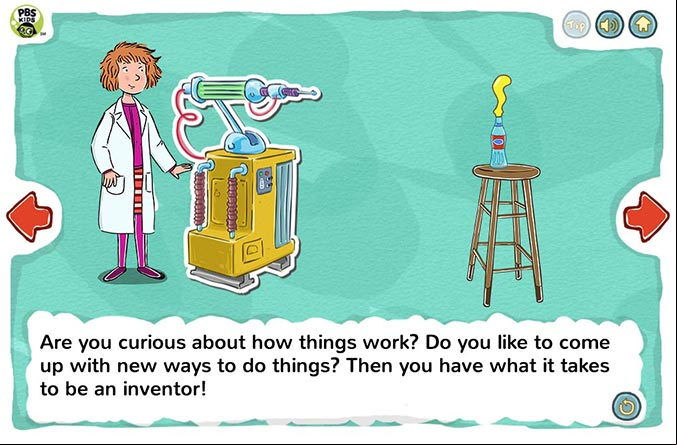
The "Truth" about Nonfiction 5t4d46
When you think of children's books, you may think of much-loved fictional stories—picture books and chapter books that are wonderful to read and enjoy. But nonfiction—books of facts and true stories (including Martha's True Stories!)—are some of the most exciting children's books around today.
Besides being about fascinating people, places, and things, nonfiction creates an important foundation for learning. Reading nonfiction not only helps kids learn about subjects such as art, science, or history, it helps build their literacy and vocabulary skills. When you tap into a child's special interests, it can also help reluctant readers want to read.
You can find nonfiction books in libraries, bookstores (look for books on sale), supermarkets, yard sales, and second-hand stores. And the great thing about nonfiction is that it's everywhere—when you and your child browse though a magazine, read a newspaper, look at street signs, follow directions or recipes. Reading the cereal box at the kitchen table or a flyer at the store counts, too!
Here are some ways to get your child enthusiastic about nonfiction:
- Your child probably has a ion for something—jokes, animals, cars, ballet, and so on. Look for nonfiction on your child's favorite subject.
- Make connections with what's happening in your child's life. Are you about to take a vacation? Find books, maps, or websites about where you are going. Is there a national election in the news? Get books about presidents, pets in the White House, or famous leaders from long ago.
- Consider the fiction your child likes and find books of nonfiction to match. Is your child a Martha Speaks fan? Find books about helper dogs, or how to care for puppies, or the Iditarod sled dog race.
- Reading about one thing can lead to another aspect of the same topic. Does your child love to read sports stories? Find biographies of athletes, how the Olympics started, or look through the sports section of the newspaper.
- If your child is really ionate about something, he or she may enjoy looking through or even reading a more advanced book on the subject, especially if there are lots of great photographs and/or illustrations.
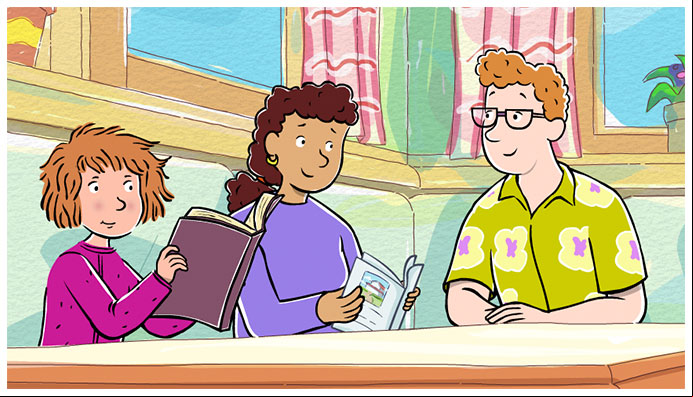
How to "Read" Nonfiction 6s4m4h
Here are some tips for reading nonfiction with your child:
- You don't necessarily have to read every page or from the beginning until the end. Browse through the book and stop on a page that looks interesting.
- Notice and read the different kinds of print: captions under the photos or illustrations, sidebars, diagrams, charts, maps, and so on.
- Looking for a particular fact or section? Check the table of contents at the beginning or the index at the end.
- If the book has a timeline, show your child how to follow it so that he or she understands that it indicates what happened when.
- Although you can't take them home, reference books at the library include really cool dictionaries, encyclopedias, and other books brimming with great information, graphics, and pictures.
- Check out the "oversized" books in the nonfiction section of the children's room. They may be shelved in a separate area (check with the children's librarian). Often these books contain spectacular illustrations.
- Nonfiction series can open up new worlds of information. (Again, ask the children's librarian for suggestions.) Once you've enjoyed one book in a series, you can look for other topics in that same series.
Learning New Words: the PET Method* 5v631r
Just as the stories in Martha's True Stories highlight new words and gives easy-to-understand definitions, nonfiction offers a great opportunity to learn new and different words. Your child may find some of the words challenging at first. An easy way to help him or her tackle unfamiliar vocabulary is to use the PET method:
P = Pronounce the word. Say the world and have your child repeat it after you.
E = Explain the word. Provide a simple definition and then give some examples of how to use the word in a sentence. If you speak a language other than English at home, use the word in your home language.
T = Try it out. Ask your child to try using the word in a sentence.
Once your child has learned the words, look for other places where the word occurs. Encourage our child to use the word in conversation whenever possible.
* The PET strategy were developed by Martha Speaks advisor Dr. Rebecca Silverman, University of Maryland.
Martha's True Stories Chart 2r251i
| Story | What it's about | Words to learn | Take it further |
|---|---|---|---|
| Math/Measuring | |||
| Who needs to measure? Explore how bakers, doctors, carpenters, police officers, and others use measurement. | apply, distance, determine, height, length, measure, scale, speed, weight | At the supermarket, look for packaging that uses size words such as "big," "giant," "huge," and so on. | |
| To plan a birthday for Jeffy the elephant, it’s important to make sure he’ll fit on stage. | approximate, check, compare, estimate, equals, exact, heavy, huge, width | At the zoo, read signs and labels to find out the size of each animal is. Which ones are the biggest? Which ones are the smallest? Your local library also has great books about large and small animals. | |
| Follow this recipe to make delicious dog biscuits—in real life or online. | add, amount, combine, degree, divide, level, mix, portion, temperature | Read recipes in cookbooks, magazines, and newspapers. Choose one to make! Challenge your child to create his or her own recipe. Write it down—your child can illustrate the steps with pictures. | |
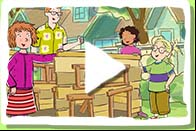 MARTHA SPEAKS Video: Martha in the Doghouse MARTHA SPEAKS Video: Martha in the Doghouse |
Martha just wants a place to take a nap. All she needs is for everybody to be quiet for, oh, 16 hours a day. Is that too much to ask? | architect, blueprint, building, construct, model, shelter, sketch tools | Watch the video with your child. Listen and learn new words as you enjoy the adventures of Martha and her friends. |
| Science/Environment | |||
| As kids learn about life under the ground, right in their own backyard, they discover how an ecosystem works. | bacteria, creature, decay, depend, ecosystem, fertilize, habitat, identify, observe | At the grocery store or nursery, read seed packets to find out more about what plants and vegetables need to grow. Talk about which vegetables grow above ground (such as tomatoes) and which ones grow below ground (such as carrots). | |
| Explore the fate of a soup can after it is used—what happens if you discard it, reuse it, or recycle it? | choice, consequences, decide, decompose, garbage, environment, reuse, polluting, repurpose | Read labels on products (such as plastic containers, clothing, or notebooks) to see if a product was made from recycled materials. Look online for videos about the recycling process or how kids can recycle. | |
| This information graphic shows how recycled materials are reprocessed and made into new products. | compost, container, dispose, dumpster, material, plastic, separate, sort, waste | Look for posters and signs that indicate where and how to recycle things. Your city or town may have booklets to read as well. | |
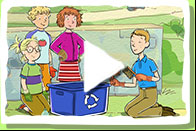 MARTHA SPEAKS Video: Paws and Effect MARTHA SPEAKS Video: Paws and Effect |
When Martha gets a piece of glass in her paw, everyone realizes that littering hurts more than the environment. But what can they do about it? | careless, debris, discard, important, injured, litter, recycle, thoughtless, trash | Watch the video with your child. Listen and learn new words as you enjoy the adventures of Martha and her friends. |
| Technology | |||
| You want to have an ice cream party, but the power is out. How can you let others know about it? | communications, complex, , information, innovation, message, signal, simple, technology | At the post office, look at the different kinds of stamps. What images are on them? Do they celebrate a person or event? Use one to send a letter or postcard to someone! | |
| To get to your championship hockey game on time, you’ll have to choose the best method of transportation to use. | accelerate, automatic, engine, gears, link, rotate, transportation, travel, vehicle | In a car or on a bus, read street and traffic signs such as "Stop," "All traffic must turn right," and so on. If there are unfamiliar words on the sign (for example, "yield"), define them. Point out and explain signs that contain only symbols. | |
| This instruction manual tells you how to build a robot. | assemble, detach, directions, connect, instructions, manual, parts, pieces, steps | What if you or your child came with instructions? What might some of them be? Together, make a manual for your family. (For example, "Have plenty of pizza for Dad.") | |
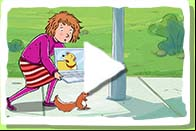 MARTHA SPEAKS Video: Virtually Martha MARTHA SPEAKS Video: Virtually Martha |
While playing with Alice's laptop computer, Martha accidentally hits the wrong button and gets zapped inside! | computer, attach, delete, desktop/laptop, (e)mail, file, folder, icon, send | Watch the video with your child. Listen and learn new words as you enjoy the adventures of Martha and her friends. |
| Engineering/Inventions | |||
| Helen tries to create a doggy dish invention for Martha and Skits. | attempt, curious, develop, envision, experiment, improvement, plan, produce, succeed | What inventor would you like to know more about? Steve Jobs? Margaret Knight? Select one and read all about him or her in a biography that you borrow from the library. | |
| Find out how animals have inspired some of our most amazing inventions—from airplanes to swimsuits. | concept, copy, create, discover, explain, inspire, original, mimic, similar | Buy or borrow a comic book about superheroes to read. Look in the newspaper or online to read a review of a movie about superheroes. | |
| Explore T.D.'s favorite subject—bubble gum—through the website he creates. | demonstrate, evidence, improvise, ingredient, inspect, prepare, prove, research, study | Browse the pbskids.tvgratuite.org website. Can you find your favorite show's site (including Martha Speaks!)? What else can you find? What features do you like best? | |
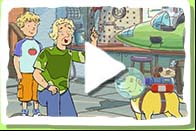 MARTHA SPEAKS Video: Itchy Martha MARTHA SPEAKS Video: Itchy Martha |
What it’s about: Martha has to wear a cone on her head to keep her from scratching. But Martha hates the cone and it terrifies Jake. Will Martha have to live in the cellar until she gets better? | contraption, device, devise, gadget, helmet, idea, inventor/tion/ive, machine, variation | Watch the video with your child. Listen and learn new words as you enjoy the adventures of Martha and her friends. |

